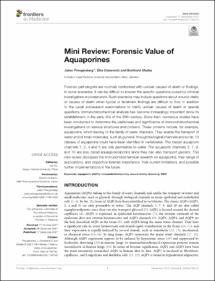Prangenberg, Julian; Doberentz, Elke; Madea, Burkhard: Mini Review: Forensic Value of Aquaporines. In: Frontiers in Medicine. 2021, vol. 8, Art. 793140, 1-6.
Online-Ausgabe in bonndoc: https://hdl.handle.net/20.500.11811/10622
Online-Ausgabe in bonndoc: https://hdl.handle.net/20.500.11811/10622
@article{handle:20.500.11811/10622,
author = {{Julian Prangenberg} and {Elke Doberentz} and {Burkhard Madea}},
title = {Mini Review: Forensic Value of Aquaporines},
publisher = {Frontiers},
year = 2021,
month = dec,
journal = {Frontiers in Medicine},
volume = 2021, vol. 8,
number = Art. 793140,
pages = 1--6,
note = {Forensic pathologists are routinely confronted with unclear causes of death or findings. In some scenarios, it can be difficult to answer the specific questions posed by criminal investigators or prosecutors. Such scenarios may include questions about wound vitality or causes of death when typical or landmark findings are difficult to find. In addition to the usual subsequent examinations to clarify unclear causes of death or special questions, immunohistochemical analysis has become increasingly important since its establishment in the early 40s of the 20th century. Since then, numerous studies have been conducted to determine the usefulness and significance of immunohistochemical investigations on various structures and proteins. These proteins include, for example, aquaporins, which belong to the family of water channels. They enable the transport of water and of small molecules, such as glycerol, through biological channels and so far, 13 classes of aquaporins could have been identified in vertebrates. The classic aquaporin channels 1, 2, 4 and 5 are only permeable to water. The aquaporin channels 3, 7, 9, and 10 are also called aquaglycerolporins since they can also transport glycerol. This mini review discusses the immunohistochemical research on aquaporins, their range of applications, and respective forensic importance, their current limitations, and possible further implementations in the future.},
url = {https://hdl.handle.net/20.500.11811/10622}
}
author = {{Julian Prangenberg} and {Elke Doberentz} and {Burkhard Madea}},
title = {Mini Review: Forensic Value of Aquaporines},
publisher = {Frontiers},
year = 2021,
month = dec,
journal = {Frontiers in Medicine},
volume = 2021, vol. 8,
number = Art. 793140,
pages = 1--6,
note = {Forensic pathologists are routinely confronted with unclear causes of death or findings. In some scenarios, it can be difficult to answer the specific questions posed by criminal investigators or prosecutors. Such scenarios may include questions about wound vitality or causes of death when typical or landmark findings are difficult to find. In addition to the usual subsequent examinations to clarify unclear causes of death or special questions, immunohistochemical analysis has become increasingly important since its establishment in the early 40s of the 20th century. Since then, numerous studies have been conducted to determine the usefulness and significance of immunohistochemical investigations on various structures and proteins. These proteins include, for example, aquaporins, which belong to the family of water channels. They enable the transport of water and of small molecules, such as glycerol, through biological channels and so far, 13 classes of aquaporins could have been identified in vertebrates. The classic aquaporin channels 1, 2, 4 and 5 are only permeable to water. The aquaporin channels 3, 7, 9, and 10 are also called aquaglycerolporins since they can also transport glycerol. This mini review discusses the immunohistochemical research on aquaporins, their range of applications, and respective forensic importance, their current limitations, and possible further implementations in the future.},
url = {https://hdl.handle.net/20.500.11811/10622}
}






